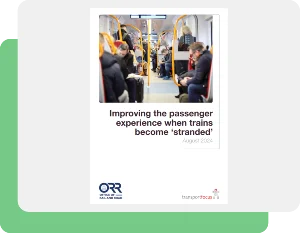 The Office of Rail and Road (ORR), and Transport Focus, have jointly called upon the industry to review the way it responds to stranded trains.
The Office of Rail and Road (ORR), and Transport Focus, have jointly called upon the industry to review the way it responds to stranded trains.
A report from the regulator and industry watchdog, published in August 2024, examines stranded train incidents and identifies the need for a greater focus on the safety, welfare and experience of passengers.
Following these findings, the industry plans to update its guidance on stranded trains later this year, and rail bosses are looking at how lessons from the past can shape changes for the future.
When trains become stranded
With so many possible causes for disruption, from storm damage to trespassers on the line, stranded trains are by no means unusual. During the 70 days of research carried out for the ORR and Transport Focus report, there were 75 incidents, that’s just over one a day, with each affecting at least two trains.
In some cases, it may only be a few minutes before passengers in a stranded train are on their way again with minimal interruption to their journey. However, other situations involve much longer waits to the point where train batteries run out of power and on-board facilities such as lighting, air conditioning, heating and lavatories stop working.
The risk is that passengers who are uncomfortable, thirsty, anxious or late for a flight take matters into their own hands and climb out of trains on to the track, putting their safety – and their lives – at risk. Something which occurred in six of the 75 incidents recorded for the report.
Ultimately, the way stranded train incidents are handled can have a direct impact on passenger welfare, and that’s what the rail industry plans to address.
Records of stranded train incidents
For rail operators wanting to improve planning for stranded trains, looking back at historical data can help them understand what is causing these incidents, where they are happening and how long they last.
However, pulling together information on stranded train incidents can be a very manual process. It could involve searching through hand-written reports which have been filed away in the archives, scrolling through logs held in databases or accessing information from disparate systems.
Even then it can be difficult to identify important factors such as how many additional services were held up as a result of the original stranded train, or where passengers were eventually evacuated.
Having better and more easily accessible intelligence on stranded trains will help train operators quantify issues and analyse the factors around them so they can make improvements.
Insight for stranded train planning
A digital tool which could join up all the information about a stranded train into a single, PDF report would enable rail operators to review all the circumstances surrounding an incident.
This might include how long a train was delayed, where the train was stranded and whether it was held at a station where passengers could safely leave the train. It could also identify how many other services were impacted as a result.
It might also be possible to factor in additional information such as whether the electricity supply had been lost, how many passengers were on board, and if that included any vulnerable people, or passengers with disabilities.
Having a record of the person in charge of that train could help too, as they might be able to shed more light on what happened that day and how they and their crew were able to manage the situation as it unfolded.
By storing this information in digital reports, rail operators could use it to carry out analytics on stranded train incidents which would provide insight for future planning.
Training and development for rail staff
The ORR and Transport Focus report mentions that passengers praised train staff for ‘carrying the day’ and being ‘really, really helpful’ during incidents, which is a positive reflection on how well many train crews support passengers through challenging situations.
However, the report also highlights a need for specific training so staff are better prepared to help passengers when trains become stranded.
Having more accurate records on past incidents would help train operators plan staff development programmes with a particular focus on passenger service while on board a stranded train, and support for passengers’ onward journeys.
With around 1.61 billion journeys made by rail passengers in Great Britain in a year, there are bound to be some which don’t go according to plan. But with a clearer understanding about the causes and impacts of incidents, rail operators will be better placed to manage passenger welfare when the unexpected does happen.
Discover how RailSmart IMS can help you manage incidents such as stranded trains.



